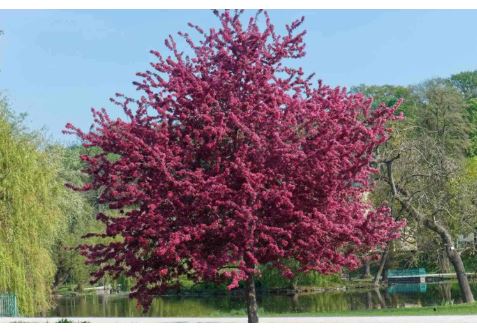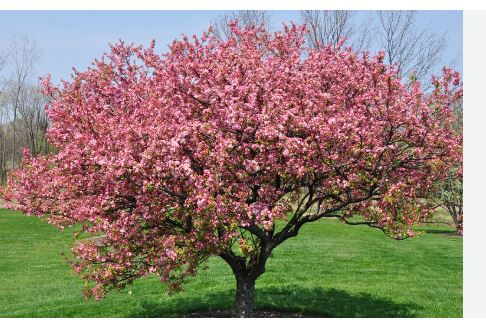
The Japanese Flowering Crabapple (Malus floribunda), also known as the Showy Crabapple or Japanese Crabapple, is a breathtaking, disease-resistant ornamental tree renowned for its profuse spring blossoms, colorful fruits, and elegant, spreading form.
As a species within the Malus genus, this deciduous tree is a favorite among gardeners, landscapers, and urban planners for its vibrant seasonal displays, adaptability, and low-maintenance care. Its cascading blooms and wildlife-friendly traits make it a standout in small gardens, parks, and city landscapes.
Botanical Classification
The Japanese Flowering Crabapple belongs to the following taxonomic classification:
- Kingdom: Plantae
- Phylum: Tracheophyta
- Class: Magnoliopsida
- Order: Rosales
- Family: Rosaceae
- Genus: Malus
- Species: floribunda
- Common Names: Japanese Flowering Crabapple, Showy Crabapple, Japanese Crabapple
Unlike many hybrid crabapple cultivars, Malus floribunda is a true species within the Malus genus, which includes both apples and crabapples. Crabapples are typically defined by their smaller fruit (less than 2 inches in diameter). Malus floribunda is a wild species native to East Asia, valued for its ornamental beauty and genetic contributions to many modern crabapple cultivars, such as Sargent and Evereste.
History of the Japanese Flowering Crabapple
The Japanese Flowering Crabapple has a storied history in its native East Asia, where it has been cultivated for centuries for its ornamental qualities and cultural significance. Originating in Japan, Korea, and parts of China, Malus floribunda was first documented in Western horticulture in the mid-19th century when European and American plant explorers, such as Philipp Franz von Siebold and Robert Fortune, introduced it to Europe and North America. By the 1860s, it was widely planted in Western gardens, prized for its cascading blooms and graceful form.
The tree gained prominence in the Arnold Arboretum of Harvard University, where it was studied and hybridized to create disease-resistant cultivars. Its genetic resilience and aesthetic appeal made it a key parent species for modern crabapples, contributing to cultivars like Indian Magic and Red Jewel. In Japan, Malus floribunda holds cultural significance, often planted in temple gardens and celebrated during hanami (cherry blossom viewing) for its floral display. Today, it is a staple in temperate landscapes worldwide, valued for its beauty and ecological benefits.
Native Area
Malus floribunda is native to East Asia, with a range spanning:
- Japan (Hokkaido, Honshu, Shikoku, Kyushu)
- Korea (Korean Peninsula)
- Eastern China (coastal regions, including Shandong and Jiangsu)
It thrives in temperate climates, typically found in open woodlands, forest edges, and hillsides at elevations up to 3,000 feet. The tree’s natural habitat includes areas with cold winters and warm, humid summers, contributing to its adaptability. While not native to North America, Malus floribunda has naturalized in some regions since its introduction in the 19th century, particularly in the northeastern United States and Canada, where it is grown as an ornamental tree.
Identifying Characteristics

The Japanese Flowering Crabapple is known for its graceful form, abundant blooms, and colorful fruits.
- Size and Shape: This small to medium deciduous tree grows to a height of 15–25 feet with a spread of 15–30 feet, forming a broad, rounded, or spreading canopy with arching branches. Its low, wide-spreading habit gives it a graceful, cascading appearance, ideal for open landscapes.
- Foliage: The leaves are simple, ovate to elliptical, 2–3 inches long, with finely serrated margins. They emerge bronze-green in spring, mature to dark green with a glossy finish in summer, and turn yellow to orange in fall, providing vibrant seasonal interest.
- Flowers: In early to mid spring (April–May), the tree produces profuse fragrant, single to semi-double flowers (1–1.5 inches in diameter) that open from deep pink to red buds. The blooms fade to pale pink or white as they mature, creating a two-toned effect that blankets the branches. Arranged in clusters (corymbs), the flowers attract pollinators like honeybees, bumblebees, mason bees, and butterflies.
- Fruit: Following the blooms, the tree develops small, red to yellow pomes (0.3–0.5 inches in diameter), ripening in late summer to early fall (August–October). These berry-like fruits persist into late fall or early winter, providing food for wildlife. The fruits are tart but edible, with a crisp, apple-like flavor.
- Bark: The bark is greyish-brown, smooth when young, and becomes slightly scaly or fissured with age. It adds subtle texture to the winter silhouette, especially when the arching branches are bare.
- Growth Habit: The tree’s broad, spreading canopy with arching, sometimes weeping branches creates a graceful, open form. Its low, wide habit makes it a striking focal point in landscapes, though it may require pruning to maintain clearance in urban settings.
Uses of the Japanese Flowering Crabapple
Malus floribunda is a multi-purpose tree valued for its ornamental beauty, ecological contributions, and practical applications. Its uses include:
- Landscaping: The tree’s cascading blooms, colorful fruit, and graceful form make it ideal for specimen planting, accent trees, group plantings, or informal hedges. Its spreading canopy suits open lawns, parks, cottage gardens, or Japanese-style gardens. It can be planted under power lines due to its moderate height or used as a backdrop for perennial borders.
- Culinary Uses: The small, tart fruits are edible and high in pectin, making them suitable for jellies, preserves, sauces, cider, and vinegar. While not typically eaten raw due to their astringency, they can be sweetened and cooked for culinary use, offering a tangy, apple-like flavor. In Japan, the fruits are sometimes used in traditional sweets or fermented beverages.
- Wildlife Support: The fragrant flowers attract pollinators like honeybees, bumblebees, mason bees, and butterflies (e.g., Eastern Tiger Swallowtail, Viceroy), supporting early-season pollination. The persistent fruits are a vital food source for songbirds (e.g., robins, cedar waxwings, bluebirds) and small mammals (e.g., squirrels, foxes) from late summer through winter. The tree also serves as a host plant for butterfly and moth larvae, supporting up to 256 species in some regions.
- Pollination: Malus floribunda is self-sterile, requiring cross-pollination with another Malus species or cultivar (e.g., another crabapple or apple tree) blooming simultaneously to produce fruit. Its early to mid-season bloom and abundant pollen make it an excellent pollinator for apple trees, enhancing yields in home and commercial orchards.
- Rootstock and Hybridization: Malus floribunda is used as a rootstock for grafting apple and crabapple cultivars due to its disease resistance and adaptability. Its genetics have been instrumental in developing modern crabapple cultivars, contributing traits like profuse flowering and vibrant fruit.
- Medicinal and Traditional Uses: In East Asian traditional medicine, crabapple fruits and bark have been used to treat digestive issues, inflammation, or as an antiseptic due to their malic and tartaric acid content. The fruits were also used as a food preservative in rural communities.
- Cultural Significance: In Japan, Malus floribunda is associated with renewal and beauty, often planted in temple gardens or near shrines. Its blooms are celebrated during hanami, alongside cherry blossoms, symbolizing the fleeting nature of life.
- Wood: The hard, dense wood is occasionally used for tool handles, firewood, or as a smoking wood for foods, imparting a mild, apple-like aroma.
Growth Rate
Malus floribunda has a moderate growth rate, adding 12–18 inches per year under optimal conditions. It reaches flowering and fruiting maturity within 3–5 years and achieves its mature height of 15–25 feet in approximately 8–12 years.
On dwarf or semi-dwarf rootstocks, it may remain smaller (10–15 feet), ideal for compact gardens. Its lifespan can reach 50 years or more with proper care, making it a long-lasting addition to landscapes.
USDA Hardiness Zones
The Japanese Flowering Crabapple thrives in USDA Hardiness Zones 4–8, tolerating winter temperatures as low as -30°F and performing well in warm, temperate summers. It requires 500–600 chill hours (hours below 45°F) to break dormancy and set fruit, making it less suited for very warm climates like USDA Zone 9b or higher.
The tree prefers full sun (6+ hours daily) to maximize flowering, fruiting, and foliage health, but it tolerates partial shade with reduced bloom and fruit production. It grows best in well-drained, slightly acidic to neutral soils (pH 5.0–7.0) but adapts to a wide range of soil types, including clay, loam, and sandy soils. Once established, it is drought-tolerant, pollution-resistant, and moderately tolerant of salt spray, making it suitable for urban and coastal plantings.
Fun Fact
The Japanese Flowering Crabapple (Malus floribunda) is often mistaken for a cherry blossom tree due to its cascading pink-to-white blooms, earning it a place in Japan’s hanami celebrations alongside sakura.
Its ability to produce a cloud of fragrant flowers has inspired poets and artists for centuries, and it was one of the first crabapple species introduced to the West, captivating Victorian gardeners with its “floral waterfall” effect in spring.
Care and Maintenance Tips
To ensure the Japanese Flowering Crabapple thrives, follow these care tips:
- Planting: Choose a sunny, well-drained site with good air circulation to minimize disease. Dig a hole twice as wide and as deep as the root ball, incorporating compost to enrich slightly acidic soil. Plant in spring or fall, ensuring the root ball’s top is level with the ground. Water deeply and apply a 2–3-inch layer of organic mulch (e.g., wood chips), keeping it away from the trunk to prevent rot. Space plants 15–20 feet apart to accommodate the spreading canopy.
- Watering: Water regularly (weekly, 12–15 gallons) during the first year to establish roots, using the “finger test” (water if soil is dry 2 inches down). Once established, water during prolonged dry spells or extreme heat. Avoid overwatering to prevent root rot.
- Pruning: Prune in late winter or early spring while dormant to remove dead, diseased, or crossing branches, water sprouts, and suckers. Shape to maintain an open, spreading canopy for air circulation and aesthetic appeal. Avoid spring pruning to reduce fire blight risk. Sanitize tools between cuts to prevent disease spread.
- Fertilization: If planted in fertile soil, fertilization is rarely needed. In poor soils, apply a slow-release, balanced fertilizer (e.g., 10-10-10) or compost in early spring before growth begins. Avoid over-fertilizing, as excess nitrogen can increase disease susceptibility.
- Pest and Disease Control: Malus floribunda has good resistance to cedar-apple rust and powdery mildew but is susceptible to apple scab and fire blight, particularly in humid conditions. Monitor for minor pests like aphids, Japanese beetles, or spider mites, which can be managed with horticultural soap or beneficial insects like ladybugs. Avoid planting near junipers, which host cedar-apple rust.
- Site Selection: Plant 15–20 feet from buildings or other trees to accommodate its spreading canopy and ensure air circulation. Its low, arching branches may require clearance pruning for walkways or driveways. Avoid heavy road salt exposure, as salt tolerance is moderate.
Challenges and Considerations
While the Japanese Flowering Crabapple is low-maintenance, consider the following:
- Disease Susceptibility: The tree is susceptible to apple scab and fire blight, particularly in cool, wet springs or humid climates. Good air circulation, proper pruning, and avoiding overhead watering reduce risks.
- Fruit Drop: The small fruits may drop in late fall or early winter, requiring minimal cleanup in high-traffic areas like sidewalks or driveways. The fruit size minimizes mess compared to larger crabapples.
- Pollination Requirements: As a self-sterile species, it requires a nearby Malus cultivar or species (e.g., another crabapple or apple tree) blooming simultaneously for fruit production. Ensure a compatible pollinator is within 50–100 feet.
- Seed Toxicity: Like all Malus species, the seeds contain trace amounts of amygdalin, which can break down into cyanide if crushed and ingested in large quantities. The risk is minimal, as the tart fruits are not typically consumed raw, and whole seeds pass through the digestive system harmlessly. Supervise pets to avoid ingesting large quantities of fruit.
- Spreading Habit: The tree’s wide, low canopy may obstruct walkways or views if not pruned, requiring strategic placement in the landscape.